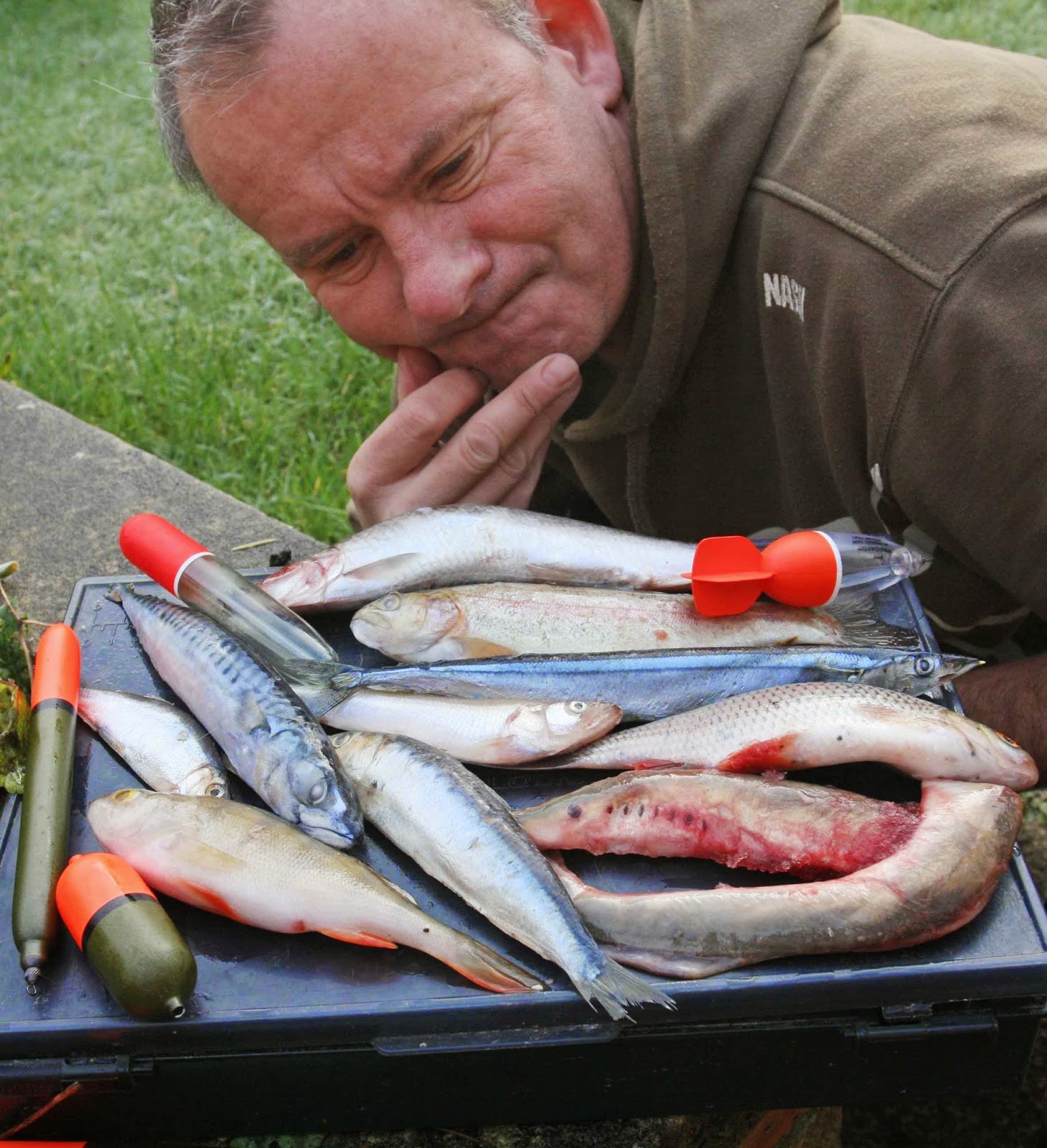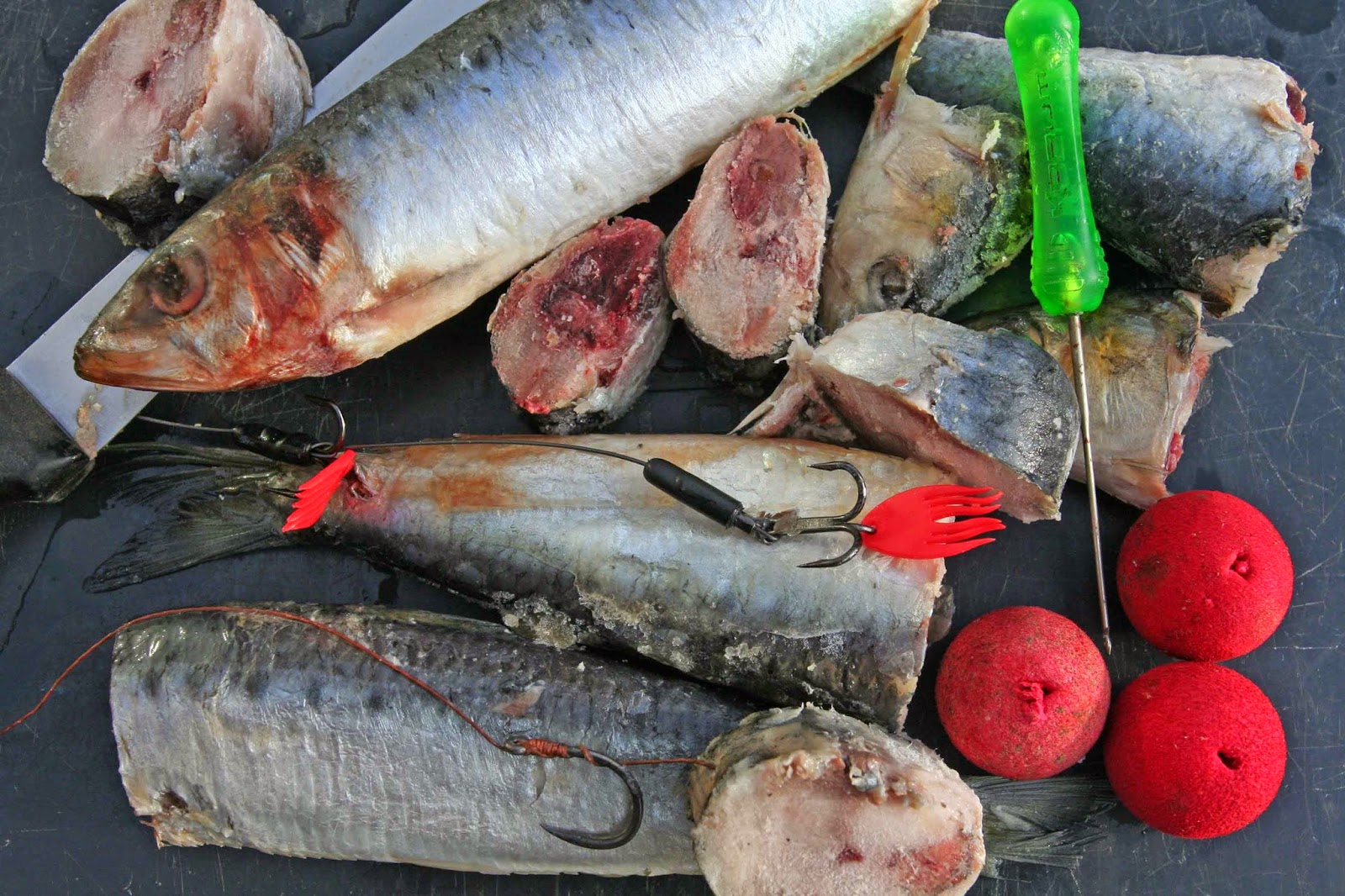
MY TOP 10 PIKE BAITS REVEALED
Predator angler Duncan Charman reveals
his top 10 best pike deadbaits and explains when, where and how to
use them. (As published in European magazine)
Without a doubt my
favourite deadbait for static pike fishing on both still and running
water. Sardines are very soft and oily which means they have to be
cast out in a frozen state. Before casting its best to pierce the
body a few times or remove the head as this will increase the thaw
under water and allow the blood and oil to disperse into the water
surrounding it giving it extra appeal. Mounting a sardine is simple
just press the barbed holding hook (nearest to the swivel) into the
tail root and then the second treble into the body just behind the
gill plate. Sardines are what I classify as an ‘instant-bait’,
where you expect to get a pickup relatively quickly and the soft skin
allow the hooks to release from the bait on the strike giving you a
very high hook-up ratio. I have also had some fantastic results by
popping up off the bottom.
Due to the soft
skin they are no good for sink-and-draw, trolling or wobbling and are
prone to being ripped apart from unwanted species like eels.
Frozen sections can also be
hair-rigged next to a big single hook and fished with devastating
results over a pre-baited area.
2 – Mackerel
 Tough skinned and
very oily make these a favourite for many, especially when pike are
found at distance and a long cast is needed. Small mackerel known as
Joey Mackerel are similar in size to a sardine and again best mounted
when frozen by placing the holding treble in the tail root and the
other behind the gill plate. Piercing or removal of the head allows
the juices to disperse into the water and a bait that can be recast a
few times once thawed out. Bigger mackerel can be cut in half with
the tail section especially good for very big fish, probably because
it can be cast out and left far longer and able to withstand the
attention of unwanted species for longer than softer baits.
Tough skinned and
very oily make these a favourite for many, especially when pike are
found at distance and a long cast is needed. Small mackerel known as
Joey Mackerel are similar in size to a sardine and again best mounted
when frozen by placing the holding treble in the tail root and the
other behind the gill plate. Piercing or removal of the head allows
the juices to disperse into the water and a bait that can be recast a
few times once thawed out. Bigger mackerel can be cut in half with
the tail section especially good for very big fish, probably because
it can be cast out and left far longer and able to withstand the
attention of unwanted species for longer than softer baits.
Being toughed skin
allows them to be used in techniques where movement is required but
generally considered more as a static bottom bait. I tend to use
bigger hooks with mackerel as it’s harder to set the hooks on the
strike compared with a soft skinned bait and you often find the bait
still in the pikes mouth after capture.
3 – Roach
Without a doubt
one of the most versatile of all natural baits and one that I landed
many a big pike on including my best of 31lb 10oz. Its slim lined
body and tough skin makes it a good caster both frozen and thawed,
however a couple of turns of bait elastic is recommended once thawed.
Small roach are great when packs of pike have rounded shoals of bait
fish up and can be retrieved back through these in a sink-and-draw or
wobbled fashion, or even simply fished under a float at different
depths.
 Bigger roach can
be used as a static deadbait, mounted with the holding treble set in
the tail root and second in its flank, popped up using poly balls or
critically balanced with balsa sticks. Piercing the body or removal
of the head again releases bodily fluids and small sections are
perfect for hair-rigging over a pre-bait.
Bigger roach can
be used as a static deadbait, mounted with the holding treble set in
the tail root and second in its flank, popped up using poly balls or
critically balanced with balsa sticks. Piercing the body or removal
of the head again releases bodily fluids and small sections are
perfect for hair-rigging over a pre-bait.
Equally productive
on both running or still water and great for trolling, wobbling or
sink-and-draw techniques when mounted with the holding hook placed in
the head and once again some bait elastic wrapped around will prolong
its life.
4 – Trout
Probably the best
bait when it comes to inflicting movement as its tough skin will
withstand casting all day so its number one for trolling, wobbling or
retrieving in a sink-and-draw fashion. Always place the holding hook
in the head of the deadbait when the above techniques are used and
due to their size often two trebles are set along its flank with a
single it its head.
 It’s also a bait
that often scores when all else fails so pays to always have a couple
for such a situation. Obviously a top scorer on large gravel pits
that are stocked with trout (if allowed) and a bait that has also
accounted for many a big fish on pressurised venues where everything
else has been tried and the pike have wised up.
It’s also a bait
that often scores when all else fails so pays to always have a couple
for such a situation. Obviously a top scorer on large gravel pits
that are stocked with trout (if allowed) and a bait that has also
accounted for many a big fish on pressurised venues where everything
else has been tried and the pike have wised up.
5 – Smelt
The most distinctive factor about a
smelt is its smell, similar to cucumber! These yellow slim lined
supple sea fish are again something every pike angler has to have as
on a tough day they often score when all else fails. Just because
they aren’t that big doesn’t mean they don’t catch big pike,
they do. Brilliant bait when movement is inflicted and often mounted
by using a big single holding hook placed in the skull and a treble
down its flank. Brilliant for wobbling and sink-and-draw tactics when
pike have shoaled bait fish up, especially those venues with a
natural bait ban, although wrapping some bait-elastic around is
recommended. Not often associated with trolling, but works well as a
static bait and one that can easily be popped up by simply injecting
air into the body.
6 – Sprat
These small silver sea fish aren’t
associated with big fish but are what many anglers start using in
their early days of pike fishing as they are cheap and replicate
small baitfish that pike feed on. Very soft skinned mean they need to
be mounted on hooks frozen and wont withstand powerful or repeated
casts. Often only lipped hooked and fished under a float when pike
are feeding heavily on live fish and one good tip is to fish a single
treble and place a small sprat on each hook.
Absolutely no use when any amount of
movement is inflicted and due to their soft delicate skin not a bait
that can be left out for long when static deadbaiting but a bait that
mimics small roach very well.
7 – Perch
Not as easily obtainable as other
natural baits such as roach but many a pike angler’s first choice
for wobbling, sink-and-draw or spinning tactics. Spinning is
completely different to that of wobbling or sink-and-draw as this
involves creating a kink in the perch by keeping the wire taught.
Mounting a perch head-up (holding hook nearest the trace swivel in
the head) with a kink in it makes it spin in the water and the deep
body of a perch works much better and creates much more flashes and
an agitated movement than slimmer fish such as roach.
Also a very good, tough static
deadbait and one that casts well and will withstand the attention of
nuisance species for far longer than that of a soft skinned bait.
Piercing the flank or removing the head also adds attraction and when
deadbaiting the holding hook needs to be placed in tail of the perch.
8 – Herring
This is classified as the in-between
to a sardine and a mackerel and is popular as it casts well when
frozen, is really oily, has a skin that’s tougher than a sardine
allowing hooks to be set in a pikes mouth easier on the strike but
then not as durable as a mackerel. Small herrings can be mounted like
sardines, along with their heads removed or body pierced for extra
attraction or cut in half when bigger and fished as a big fish static
deadbait, one that can be left out longer.
Certainly too soft for any use when
movement is needed but a bait that takes on colour well so often used
to outwit wary predators that have seen it all. I’ve had some great
results trotting these down a river under a float when pike are
feeding on big silver fish as its silver skin replicates these well.
9 – Lamprey
 This strange pike bait was all the
rage a few years ago and gave the piker something totally different
to the standard fish looking deadbait. Long and thin with a very
tough skin it looks similar to an eel and it’s full of blood. Its
tough skin and strange shape allows it to be fished in a
sink-and-draw fashion, wobbled even slowly retrieved back just off
the bottom, yet in most cases these are cut in half, or just a inch
off the tail and used statically allowing the blood to draw predators
in.
This strange pike bait was all the
rage a few years ago and gave the piker something totally different
to the standard fish looking deadbait. Long and thin with a very
tough skin it looks similar to an eel and it’s full of blood. Its
tough skin and strange shape allows it to be fished in a
sink-and-draw fashion, wobbled even slowly retrieved back just off
the bottom, yet in most cases these are cut in half, or just a inch
off the tail and used statically allowing the blood to draw predators
in.
It’s also a very good bait to use in
the up-and-coming single hook style of fishing and hair-rigged behind
a big single and seems to catch not just pike but perch, zander and
strangely carp!
10 – Bluey
 This strange looking sea fish seems to
have taken pike fishing to a new level as anglers seek to find edges
over others. Normally around twelve inches long this long thin silver
sea fish is usually cut in half and fished statically on pressured
venues where anglers are prepared to sit and wait but a few have been
inflicting movement with startling results, so don’t ignore
mounting these head-up’ and twitching back.
This strange looking sea fish seems to
have taken pike fishing to a new level as anglers seek to find edges
over others. Normally around twelve inches long this long thin silver
sea fish is usually cut in half and fished statically on pressured
venues where anglers are prepared to sit and wait but a few have been
inflicting movement with startling results, so don’t ignore
mounting these head-up’ and twitching back.
Its thin body is ideal for those
conservation minded anglers that are finding just how successful
hair-rigging fish sections next to a big single hook is and fishing
over a spot that’s been pre-baited.





.jpg)


























